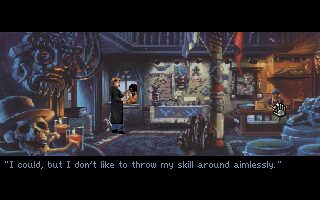
Author: GN Team - Published: 20 July 2025, 7:15 pm
Soldier Blade is a vertical shoot 'em up developed by Hudson Soft and published in 1992 for PC Engine/TurboGrafx-16. This title represents one of the pinnacles of the genre on NEC's console, offering a pure arcade shooting experience that fits into the tradition of classics like R-Type, Gradius, and Thunder Force III.
The player takes control of a futuristic fighter that resembles '90s jet fighter concepts, navigating through a series of "Operations" that, despite their sophisticated name evoking espionage missions, simply consist of systematically annihilating everything moving on screen. The military nomenclature adds a touch of class to what is essentially a festival of pure destruction, where the objective is to line up your ship with overwhelming forces of enemy fighters, turrets, mech units, battleships, and floating fortresses of every kind.
Read More
Author: GN Team - Published: 20 July 2025, 2:39 pm
Dylan Dog: La Regina delle Tenebre (The Queen of Darkness) is a platform adventure developed by Simulmondo and published in 1992 for PC and Amiga. It's the first chapter of a series of games inspired by the famous Italian comic book from Bonelli Editore. The game was designed by Ivan Venturi with creative supervision by Francesco Carlà, in an ambitious attempt to transform the noir atmospheres of Tiziano Sclavi's character into a video game experience.
Simulmondo faced a complex challenge: how to digitally recreate the charm that drove Italian readers to regularly purchase issues of the Nightmare Investigator, which was extremely popular in Italy in the 90s? The solution adopted was intelligent and respectful of the original material. Rather than adapting the comic book stories—an operation that would be almost impossible anyway—the developers created original plots inspired by the characters and stories from the comic, changing and reinventing them. The Queen of Darkness in the game, for example, is not the student that someone might remember from the comic book issue, but a sexy and provocative demon.
Read More
Author: Maddie - Published: 18 July 2025, 7:39 pm
King's Quest is an adventure game developed by Sierra On-Line and released in 1984, initially for IBM PC compatibles. It was also ported to Apple II, Amiga, Atari ST, and other platforms. It was also ported to MS-DOS (the 1984 version was a PC Booter disk). The game was designed by Roberta Williams, who would become known as the "Queen of Adventure Games" for her pioneering work in establishing the graphical adventure genre.
Williams created something truly revolutionary with King's Quest. In an era dominated by text adventures like Zork: The Great Underground Empire and simple arcade games with blocky graphics, Sierra delivered a full-color fantasy world where players could actually move their character around detailed environments. Using the company's new Adventure Game Interpreter (AGI) engine, the game featured extended CGA graphics (the game was built for the PCjr, which had a custom, 320x200 16-color graphics not available on standard CGA), PC speaker music, and a simple text parser that allowed interactions with the game world.
Read More
Author: GN Team - Published: 18 July 2025, 5:49 pm
Gabriel Knight: Sins of the Fathers is an adventure game developed by Sierra On-Line and released in 1993 for MS-DOS. The game was designed by Jane Jensen, who also wrote the compelling storyline that would establish one of Sierra's most mature and atmospheric adventure series.
Jensen crafted a supernatural mystery that stands apart from Sierra's typically lighter fare like King's Quest or Space Quest. You play as Gabriel Knight, a struggling New Orleans novelist who becomes obsessed with a series of voodoo murders plaguing the city. What starts as research for his next book gradually reveals Gabriel's own dark heritage as a member of an ancient German family line of "Schattenjägers" - shadow hunters who combat supernatural evil.
Read More
Author: GN Team - Published: 18 July 2025, 4:51 pm
Nemesis 2 is a side-scrolling shoot-em-up developed by Konami for the MSX computer system and released in 1987. Known as Gradius 2 in Japan, the game represents Konami's ambitious attempt to create a console-exclusive entry in their acclaimed space shooter series, taking full advantage of the MSX platform's capabilities.
Set in the distant future, players pilot the Vic Viper starfighter through a series of increasingly hostile alien worlds, each presenting unique environmental challenges and enemy formations. The game follows the traditional Gradius formula of collecting power capsules to enhance the ship's weaponry and defensive systems, but introduces several innovative elements that distinguish it from both its predecessor and contemporaries like R-Type or Salamander.
Read More
Author: GN Team - Published: 18 July 2025, 1:44 pm
World Games is a multi-sport athletic simulation developed by Epyx and released for the Commodore 64 in 1986. It was ported to numerous platforms, including the Amiga, Atari ST, Apple IIgs, Amstrad CPC, Sega Master System, and more. This title represents the fourth entry in Epyx's groundbreaking "Games" series, which began with the revolutionary Summer Games on the Commodore 64, a masterpiece that established the template for Olympic-style sports simulations and demonstrated the potential for creating authentic athletic experiences on home computers.
Read More